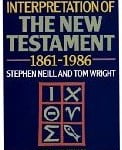N. T. Wright’s revision of Stephen Neill’s, Interpretation of the New Testament, 1861–1986, attempts a concise, but significantly narratival, survey of various issues in New Testament scholarship during the period in question. To this end, Neill and Wright discuss: (i) the challenge to orthodoxy (1–34); (ii) the New Testament and its relationship to history (35–64); (iii) what the New Testament says and means (65–111); (iv) Jesus and His relationship to the Gospel (112–46); (v) Greeks and their relationship to Christians (147–204); (vi) “Re-enter[ing] Theology” (205–51); (vii) the theory of a gospel behind the Gospels (252–312); (viii) the Jewish background of the Gospel (313–59); and (ix) the relationship between history and theology (360–449).
While examining the challenge to orthodoxy, Neill and Wright concentrate on summarizing the noteworthy, continental contributions to New Testament interpretation from Enlightenment’s early days through the middle 1800s. “The New Testament and History” continues this examination, while giving special emphasis to the work of “the Cambridge three” of Lightfoot, Westcott, and Hort. Chapter three discusses developments and issues in textual criticism and exegesis. “Jesus and the Gospel” handles research on the synoptic tradition, especially as relates to the synoptic problem. “Greeks and Christians” mainly investigates the possibilities for and evidence of influence of Greek thought on the development of earliest Christianity. In the chapter titled, “Re-enter Theology,” Neill and Wright concentrate almost totally on Albert Schweitzer’s Quest of the Historical Jesus, Karl Barth’s dialectical theology, and Rudolf Bultmann’s attempt to discover the Christian kerygma—that is, the essence of the Christian faith. Further, Neill and Wright examine the possibility of a written source(s) that may stand behind the synoptic Gospels. The authors also investigate the help that Judaism might provide for interpreting the New Testament. In the final chapter, “History and Theology,” the book explores, in some detail, Ed Sanders’ work in reaction to, for example, the traditional Lutheran understanding of Paul. This chapter also encourages interpreters to exhibit a certain “historical humility” in their work and concludes by restating the relevance of New Testament studies.

Leave a Reply